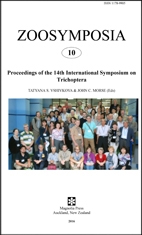Abstract
The Trichoptera barcode of life initiative has gathered barcodes for a large portion of Trichoptera species diversity. Although the primary use of these data is species identification, they can also be used to generate species-level phylogenetic hypotheses. In order to ameliorate the well-documented difficulties of resolving deep divergences with the COI barcode fragment, we used a method of defining well-supported nodes from other data sources and filling out the “leaves” within these defined nodes of the Trichoptera tree of life with trees generated from the barcode fragment. We demonstrate the potential of this approach with the generation of a tree for Xiphocentronidae + Psychomyiidae. Using this example, we present two suspicious clades that warranted a more careful analysis, and demonstrate that a simple analysis of barcodes can generate and help answer other, related questions. We find that Zelandoptila is supported as belonging to Ecnomidae rather than Psychomyiidae, and we placed an unidentified specimen from the Smithsonian National Museum of Natural History collection as sister to Beraeidae.
References
Altschul, S.F., Gish, W., Miller, W., Myers, E.W. & Lipman, D.J. (1990) Basic local alignment search tool. Journal of Molecular Biology, 215, 403–410.
http://dx.doi.org/10.1016/S0022-2836(05)80360-2Anon (2010) Adobe Illustrator. Adobe Systems, Inc., San Jose, California.
Avise, J.C. (1994) Molecular Markers, Natural History and Evolution. Springer Science & Business Media, New York, Philadelphia, 511 pp.
http://dx.doi.org/10.1007/978-1-4615-2381-9Edgar, R.C. (2004) MUSCLE: Multiple sequence alignment with high accuracy and high throughput. Nucleic Acids Research, 32, 1792–1797.
http://dx.doi.org/10.1093/nar/gkh340Flint, O.S. & Kjer, K.M. (2011) A new species of Neophylax from northern Virginia, U.S.A. (Trichoptera: Uenoidae). Proceedings of the Entomological Society of Washington, 113, 7–13.
http://dx.doi.org/10.4289/0013-8797.113.1.7Frania, H.E. & Wiggins, G.B. (1997) Analysis of morphological and behavioural evidence for the phylogeny and higher classification of Trichoptera (Insecta). Royal Ontario Museum,Life Sciences Contributions, 160, 1–67.
http://dx.doi.org/10.5962/bhl.title.53487Gouy, M., Guindon, S. & Gascuel, O. (2010) SeaView version 4: A multiplatform graphical user interface for sequence alignment and phylogenetic tree building. Molecular Biology and Evolution, 27, 221–224.
http://dx.doi.org/10.1093/molbev/msp259Hebert, P.D.N., Cywinska, A., Ball, S.L. & de Waard, J.R. (2003a) Biological identifications through DNA barcodes. Proceedings of the Royal Society B: Biological Sciences, 270, 313–321.
http://dx.doi.org/10.1098/rspb.2002.2218Hebert, P.D.N., Ratnasingham, S. & de Waard, J.R. (2003b) Barcoding animal life: cytochrome c oxidase subunit 1 divergences among closely related species. Proceedings of the Royal Society B: Biological Sciences, 270, S96–S99.
http://dx.doi.org/10.1098/rsbl.2003.0025Holzenthal, R.W., Blahnik, R.J., Kjer, K.M. and Prather, A.L. (2007) An update on the phylogeny of caddisflies (Trichoptera). In: Bueno-Soria, J., Barba-Álvarez, R. & Armitage, B.J. (Eds.), Proceedings of the 12Ith International Symposium on Trichoptera. The Caddis Press, Columbus, Ohio, pp. 143–153.
Johanson, K.A. & Espeland, M. (2010) Phylogeny of the Ecnomidae (Insecta: Trichoptera). Cladistics, 26, 36–48.
http://dx.doi.org/10.1111/j.1096-0031.2009.00276.xKjer, K.M., Blahnik, R.J. & Holzenthal, R.W. (2001) Phylogeny of Trichoptera (Caddisflies): Characterization of signal and noise within multiple datasets. Systematic Biology, 50, 781–816.
http://dx.doi.org/10.1080/106351501753462812Kjer, K.M., Blahnik, R.J. & Holzenthal, R.W. (2002) Phylogeny of caddisflies (Insecta, Trichoptera). Zoologica Scripta, 31, 83–91.
http://dx.doi.org/10.1046/j.0300-3256.2001.00079.xKjer, K.M. & Honeycutt, R.L. (2007) Site specific rates of mitochondrial genomes and the phylogeny of eutheria. BMC Evolutionary Biology, 2007, 7−8.
Neboiss, A. (1986) Atlas of Trichoptera of the SW Pacific - Australian Region. 1st Edition. Series Entomologica, 37, i–viii + 1–286.
http://dx.doi.org/10.1007/978-94-009-4814-3Nozaki, T. & Kagaya, T. (1994) A New Ernodes (Trichoptera, Beraeidae) from Japan. Japanese Journal of Entomology, 62, 193–200.
Rambaut, A. (2012) FigTree Software. Available from: http://tree.bio.ed.ac.uk/software/figtree/. (accessed 19 December 2014)
Resh, V.H. & Unzicker, J.D. (1975) Water quality monitoring and aquatic organisms: The importance of species identification. Journal − Water Pollution Control Federation, 47, 9–19.
Ruiter, D.E., Boyle, E.E. & Zhou, X. (2013) DNA barcoding facilitates associations and diagnoses for Trichoptera larvae of the Churchill (Manitoba, Canada) area. BMC Ecology, 13 (5).
http://dx.doi.org/10.1186/1472-6785-13-5Stamatakis, A., Ludwig, T. & Meier, H. (2005) RAxML-III: A fast program for maximum likelihood-based inference of large phylogenetic trees. Bioinformatics, 21, 456–463.
Sweeney, B.W., Battle, J.M., Jackson, J.K. & Dapkey, T. (2011) Can DNA barcodes of stream macroinvertebrates improve descriptions of community structure and water quality? Journal of the North American Benthological Society, 30, 195–216.
Swofford, D.L. (2003) PAUP* Phylogenetic Analysis Using Parsimony (*and Other Methods). Sinauer Associates, Sunderland, Massachusetts.
Willis, J.C. & Yule, G.U. (1922) Some statistics of evolution and geographical distribution in plants and animals, and their significance. Nature, 109, 177–179.
http://dx.doi.org/10.1038/109177a0Zhou, X., Kjer, K.M. & Morse, J.C. (2007) Associating larvae and adults of Chinese Hydropsychidae caddisflies (Insecta:Trichoptera) using DNA sequences. Journal of the North American Benthological Society, 26, 719–742.

